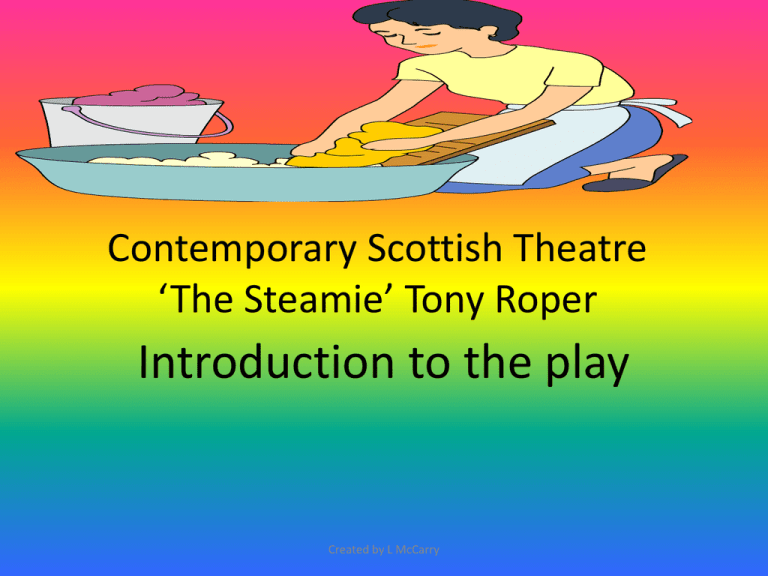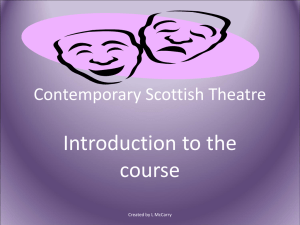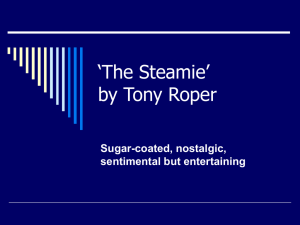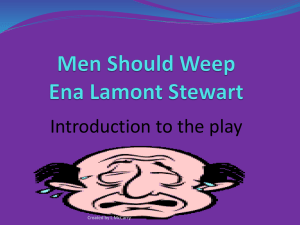Contemporary Scottish Theatre 'The Steamie' Tony Roper
advertisement

Contemporary Scottish Theatre ‘The Steamie’ Tony Roper Introduction to the play Created by L McCarry Contemporary Scottish Theatre • The play ‘The Steamie’ will be studied as part of CST element of the course. • It will be a play which you will have to reference in the CST essay in your exam. • ‘The Steamie’ can be discussed under the question selections: Social, Political and Religious Dimensions, Use of History, Nostalgia and Popular Tradition and Issues of Gender. Created by L McCarry Historical setting of the play •The play is set in 1953, just before the slum clearances of Urban Regeneration (poor housing was being knocked down in cities throughout Britain and other towns were being created to house people). •The joy of better housing brought with it a feeling of displacement and alienation for many people, especially the older generation. •Old communities were being destroyed and within a very short time, as is often the case after any major social upheaval, people found comfort in remembering or ‘imagining’ ‘The good old days.’.This is represented mainly through the character of Mrs Culfeathers. • The play is set in the 50’s but was written in the 80’s by Tony Roper. •This is a play which studies women at work but more specifically the women’s relationships and lifestyle in the 1940’s and early 50’s. It is a play exploring personal relationships in a working environment. Created by L McCarry Historical setting of the play •The main developments in the last 45 years of industrial society have led to increasing separation of people in their homes, family groups and during their leisure time. The occasions for social exchange are much fewer. •‘The Steamie’ was a place women could socialise as well as do their washing. It was like a weekly club where information and gossip was exchanged. None the less it was a chore and not recreational! •It was also a necessity as there was no hot water, washing machines, baths or tumble dryers in the home. •The washing was often transported to ‘The Steamie’ in prams, very few people had cars. •In the course of the heavy work, the chat and the gossip helped pass the time. Created by L McCarry Historical setting of the play •Social status was often defined by whether or not a man was in employment and the type of employment he was in. •Respectability was often gauged by the degree of cleanliness of the house and the people in it. •The National Health Service was established in 1948, this provided some benefits for people, but this was very broken up and people still struggled. •The play is set in the past, a recent history, but still the past and many elements of lifestyle have changed since then. Created by L McCarry Synopsis The play begins on New Year’s eve. The women are all trying to get their washing done to get home to celebrate. We are introduced to each of the characters and their various personalities. We find out about their lifestyles, backgrounds, families and working days. There are many songs in the play, which compliment and add to the themes and issues raised in the play. These are also used to tell some of the women's stories and give the audience an insight into their feelings. We meet one male character, the supervisor - Andy. He raises issues of the women’s opinions of men and the role of men in society at the time the play was written. There are many comical moments in the play and humour is used throughout the play. Created by L McCarry ‘The Steamie’ • Click HERE to see images of an original Steamie. • Click HERE to see some video clips of the play ‘The Steamie’. • Click HERE to see an interview with Tony Roper. Created by L McCarry The Characters: Mrs Molly Culfeathers •She is in her late 60’s and remembers the ‘good old days’. •She is working harder than ever as she has an ill husband and has to keep the house going herself. She has two sons and three grandchildren, who live in England and whom she never sees, obviously giving her little support. •She has been working in the Steamie for six hours on Hogmanay. She does washing for others to make money. •She is a naive character who misses a lot of the jokes but who has the respect of the others, due to her age and her sheer hard work. Dolly particularly supports her. Created by L McCarry The Characters: Magrit McGuire • She is in her late 30’s, her life revolves around her husband Peter and her children. • She sees the harshness of her life. She is cynical and has a hard life. She can be impatient with those she sees as weaker, as in Dolly and Mrs Culfeathers. • However, we do discover that there is a softer side to her as she respects her elders and apologises to Mrs Culfeathers for shouting at her. She also sticks up for Dolly when she is in the sink. • She is a working class woman (as they all are) and she sums up the role of women and tenement life in the 50’s with her song ‘Isn’t it wonderful to be a woman’. Created by L McCarry The Characters: Doreen Hood • She is 19 and has her whole life ahead of her, with the promise of a new house in Drumchapel with her husband John. • She is fashion conscious and aware of the trends of the day. She knows about the latest household gadgets etc. • She aims to have a better life than the women of previous generations (ironic as Drumchapel, is different now from what she envisaged). Created by L McCarry The Characters: Dolly Johnson • She is in her late 50’s and has a grown up family. • She likes to have a laugh and a joke and is quite naive about life. • She is prepared to use the Steamie for purposes beyond washing e.g. a wash bath and washing greasy overalls. • She likes to be of help to others. She likes conversation and goes along with others, especially Mrs Culfeathers with the story about mince and the imaginary telephone conversation with Doreen. Created by L McCarry Discussing ‘The Steamie’ • ‘The Steamie’ can be useful to mention in a ‘social’ question. The next slide highlights some areas you could prepare quotes and examples for when discussing the play. Created by L McCarry ‘The Steamie’ Housing/Living conditions Health/ Community Roles of women Work Establishment of NHS Social Conditions Created by L McCarry ‘The Steamie’ On the following slides you will find some basic notes to help you to start thinking of creating your own quotes and examples to illustrate the social conditions represented in the play. Created by L McCarry Social Conditions •The play is a social play looking at community spirit in Glasgow, which existed before the urban clearances. •Songs were added to Roper’s script, some of these have an element of social comment. •There is no bigotry or sectarianism in this play. Magrit is the only Catholic and references are made to her religion in a curious way. •The location of ‘The Steamie’ is vital in revealing the social issues. People had no amenities in their own houses and had to use ‘The Steamie’. •We do learn about working class life through the dialogue. •The women were from a close knit community, where everyone new generations of each others families and more so each others business. Created by L McCarry Social Conditions •Sense of community is also conveyed in the way they help each other e.g. Dolly helping Mrs Culfeathers and inviting her to her Hogmanay party. • The fear of losing community is also brought up in the play through the character of Mrs Culfeathers. •Roper highlights the poor health, specifically of Mrs Culfeathers, she is tired and feels she’s ‘finished’ but has to work in order to survive. •By looking at the social conditions of the time, we learn that people received very little help financially from the government. •Women accepted that their role was in the house and that any job would be purely domesticated. •The women, apart from Doreen, have no aspirations, they have accepted their fate. •The men obviously did manual work (the overalls). •Roper uses colloquial language to set the play in the period, but also to reveal the social class. Created by L McCarry ‘The Steamie’ The play can also be discussed in the ‘Issues of Gender’ essay questions. The next slide highlights some areas you could prepare quotes and examples for when discussing the play. Created by L McCarry ‘The Steamie’ Generation Differences Roles of Men Roles of women Family Stereotypes Issues of Gender Created by L McCarry ‘The Steamie’ On the following slides you will find some basic notes to help you to start thinking of creating your own quotes and examples to illustrate the ‘Issues of Gender’ represented in the play. Created by L McCarry Issues of Gender •Magrit’s song ‘Wonderful to be a woman’ sums up the women’s place in society as wives, mothers, grandmothers and as cooks, cleaners, laundry maids ‘…unpaid skivvies’. •Their lives are hard and their working days are long, they have little, if no time to themselves. •The women talk about their roles and their relationships, quite often in a negative manner. • The women mainly speak negatively about their husbands. •The women are the central characters. Created by L McCarry Issues of Gender • Some critics have views that the characters are stereotypical. •However, as the play progresses the characters seem to have more depth and wider experience than intimated at the outset. • Doreen, representing the younger generation, is the only woman who has ambitions to create a better way of life for herself. She seeks the ‘new technology’ and keeps up with fashion. She also has a different relationship with her husband and has experienced things that the other woman have not heard of. •The character of Andy is in a position of status because of his job, but the women gain the upper hand as the play progresses. They do however end up looking after Andy as he is drunk, a situation most of the women, particularly Magrit, is used to with her own husband. Created by L McCarry ‘The Steamie’ The play can also be discussed in the ‘History, Nostalgia and Popular Tradition’ essay questions. The next slide highlights some areas you could prepare quotes and examples for when discussing the play. Created by L McCarry ‘The Steamie’ Mrs Culfeathers’ Romanticised view of past Depiction of Scotland Historical setting is accurate History and Nostalgia Created by L McCarry ‘The Steamie’ Comic patter Comical stories Visual Gags Song Dance Popular Tradition Created by L McCarry ‘The Steamie’ On the following slides you will find some basic notes to help you to start thinking of creating your own quotes and examples to illustrate the elements of ‘History, Nostalgia and Popular Tradition’ represented in the play. Created by L McCarry History, Nostalgia and Popular Tradition •Roper’s reconstruction of the late 40’s and early 50’s working class life is historically accurate. •The lives the women lead were just as they would have been at the time. •Their memories, however have a ‘rose coloured tint.’ Life at the turn of the century must have been hard and full of discomfort, but there is no mention of dirt, cold, damp and disease that must have been commonplace. •Mrs Culfeathers has a romanticised view of the past, she is looking back on her youth, where she probably wasn’t aware of loneliness, rather than that it didn’t exist. •Was everything so friendly or are these memories selective or imagined? •The audience understand the ironic use of Drumchapel as a site of aspirations. •Among the popular traditions of Scotland are Pantomime, Variety and Music Hall. Stand-up comics , double acts, songs, dance and monologues are only a few of the popular traditions of theatre found in ’The Steamie’. Created by L McCarry ‘The Steamie’ In class we will specifically look at the play in terms of its relevance to: Social, Political and Religious dimensions, Issues of Gender and Popular Tradition. The next slide will give you some tasks to complete to help you to develop your knowledge of the play and prepare quotes and examples to answer in the above questions. Created by L McCarry ‘The Steamie’ Tasks 1) You will be put into groups and each group will be given a ‘Social’ heading. The group should prepare a presentation based on the social condition given. This should firstly explain the social condition. The presentation should be visual and include images. It should also include quotes and examples from the play, WITH JUSTIFICATION of the ways in which the social condition is highlighted. 2) In pairs you will be given ‘Issues of Gender’ related links to ‘The Steamie’. Again, you must create an interesting and visual presentation to reflect the quotes and examples from the play that highlight the issues of gender. Created by L McCarry Well Done! You have now completed revision of ‘The Steamie’ Created by L McCarry









